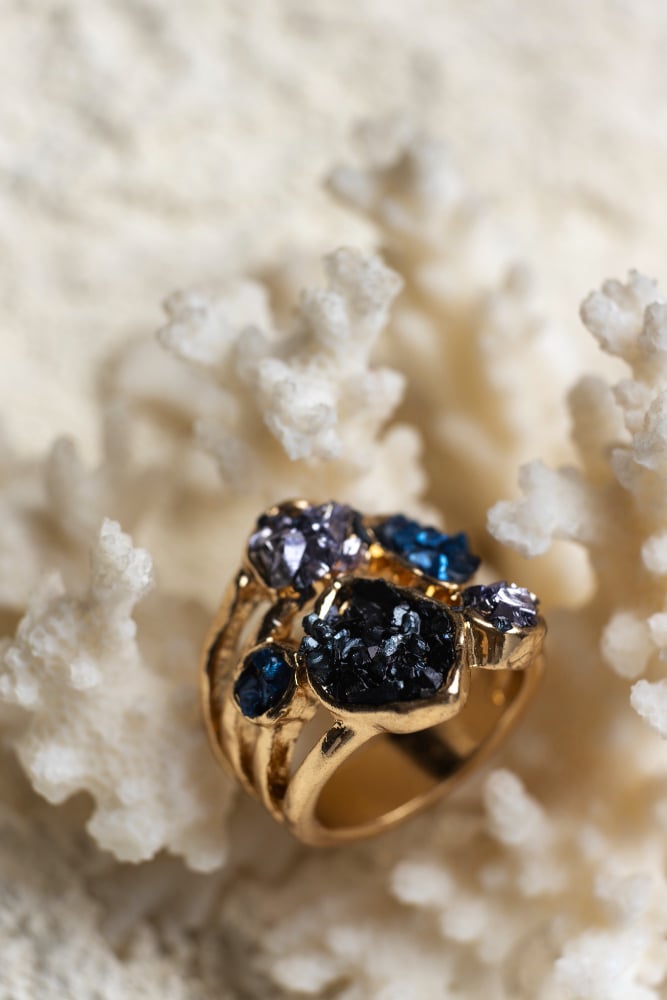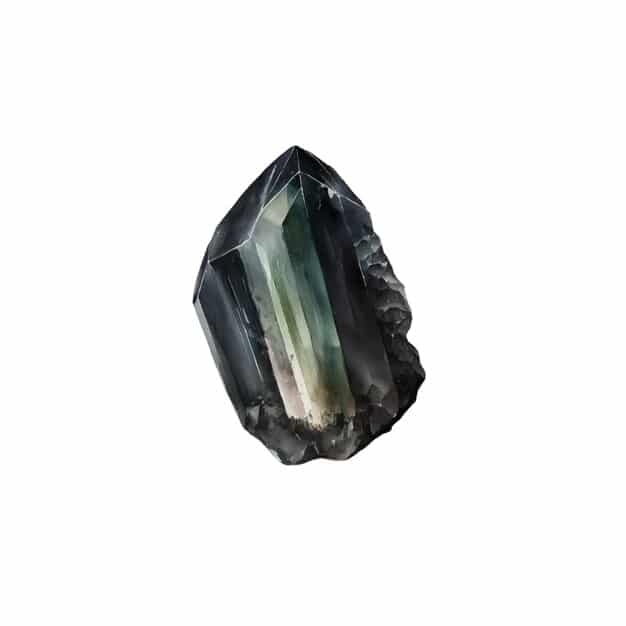
Tourmaline, a gemstone as diverse and colourful as the cultural tapestry it adorns, has long been a jewel of fascination in popular culture.
This semi-precious gemstone, known for its unparalleled spectrum of colours and unique pyroelectric properties, has not only captivated gem enthusiasts but also permeated various facets of cultural expression.
From its mystical appearances in ancient folklore and literature to its symbolic significance in contemporary fashion and art, tourmaline’s journey through the ages is as multifaceted as the stone itself.
This article delves into the enchanting world of tourmaline, exploring its historical allure, its portrayal in literary and cinematic works, and its ongoing influence in the realms of fashion and design.
So, let’s get right to it.

Tourmaline and its History
Tourmaline Black is a type of black tourmaline crystal that has been used for centuries. It is a type of semi-precious gemstone that is known for its unique properties.
Tourmaline Black is also known for its striking black color and its strength to absorb negative energy. The black tourmaline meaning is associated with protection and grounding and is often used in spiritual practices.
The history of Tourmaline Black is long and varied. It is known to have originated in India and use to come through US tourmaline trade. It has been used in jewelry, art, and even in music and fashion for centuries. It is still popular today, with many people wearing tourmaline jewelry or using tourmaline crystals during their spiritual practices.

Popular Culture Connections of Black Tourmaline
Popular culture has embraced black tourmaline, featuring it in various forms from fashion accessories to thematic elements in films and literature.
Its mystique and perceived healing properties have made it a favourite among celebrities and wellness influencers. The stone’s unique appeal continues to inspire artists and designers, securing its place in contemporary cultural trends.
Now, let’s take a look at tourmaline in popular culture.

Artistic Representations of Black Tourmaline
Throughout history, tourmaline black has been used in art. It has been used to create jewellery, sculptures, and even paintings.
In some cases, tourmaline black has been used to represent protection and grounding, while in other cases it has been used to represent strength and resilience.
In all cases, tourmaline black has been used to create beautiful works of art. Additionally, its deep, enigmatic hues have inspired artists to explore themes of mystery and introspection.
This gemstone’s versatility in art forms, from traditional to contemporary, highlights its enduring appeal.
In the world of fashion, tourmaline gemstones has emerged as a symbol of sophistication, adorning everything from haute couture to bespoke accessories. In addition to this, pink and red tourmaline are also favoured.
Its presence in visual media, from film to graphic art, further underscores its cultural and aesthetic significance.

Music Connections of Black Tourmaline
Tourmaline black has also been used in music. Many musicians have used tourmaline black in their songs to represent strength, protection, and grounding.
In some cases, musicians have even used the black tourmaline meaning in their lyrics.
For example, the band Tool used Tourmaline Black in their song “Schism” to represent grounding and protection. Moreover, the allure of tourmaline extends beyond its black variant.
Songs referencing pink tourmaline often resonate with themes of love and emotional healing, while red tourmaline, with its fiery hue, is associated with passion and vitality.
References to tourmaline deposits in lyrics subtly underscore the gemstone’s natural origin and rarity, adding a layer of authenticity and intrigue to the narrative.
The multifaceted symbolism of tourmaline in music reflects not only its physical beauty but also its strength to convey deep emotional and spiritual messages, enriching the tapestry of musical expression.

Fashion Connections of Black Tourmaline
Tourmaline black has also been used in fashion, with many people wearing tourmaline necklaces or other jewellery pieces made from tourmaline black. It is believed that black tourmaline jewellery can help protect and ground the wearer, and many people believe that it can help bring good luck and fortune.
In addition, tourmaline black is a beautiful stone, so it makes for stunning jewellery pieces. Beyond black, the fashion world has embraced green tourmaline, often used in statement pieces for its vibrant, life-affirming colour.
Designers have been increasingly fascinated by incorporating many tourmaline crystals into a single piece, creating a kaleidoscope effect that captivates the eye.
Watermelon tourmaline, with its unique pink and green colouration, has become particularly popular in contemporary jewellery, offering a playful yet sophisticated aesthetic. This trend of using various types of tourmaline in fashion not only adds a touch of natural elegance but also allows for personal expression, as each stone carries its own story and symbolism.
The versatility and natural beauty of tourmaline make it an enduring favourite in the ever-evolving world of fashion.

Literature Connections of Black Tourmaline
Tourmaline, with its myriad of hues and fascinating properties, has found a special place in the world of literature.
Gem cutters, often depicted in novels and stories, have been portrayed as artisans who skilfully reveal the hidden beauty of tourmaline, making it a symbol of discovery and transformation.
The way tourmaline occurs in nature, often in intricate and varied forms, has been a source of inspiration for authors, mirroring the complexity and depth of their characters and plots.
In poetry and prose, tourmaline is frequently referenced as a metaphor for life’s multifaceted nature, embodying emotions and experiences that are as varied as the stone’s own spectrum of colours.
The presence of tourmaline, especially as colored gemstones, in literary works often adds an element of mystique and luxury, enriching the narrative with vivid imagery and symbolism.
Characters may be seen wearing tourmaline jewellery as a representation of their wealth or status or perhaps as a talisman that holds personal or supernatural significance.
In fantasy literature, tourmaline sometimes plays a role in magical rituals or as a coveted item with hidden powers, further enhancing its mysterious and enchanting aura.
Through these literary connections, tourmaline transcends its physical form, becoming a versatile and enduring icon in the realm of storytelling.

Spiritual and Healing Practices of Black Tourmaline
The use of black tourmaline in healing and spiritual practices is steeped in ancient lore and modern metaphysical beliefs.
Historically, this striking black gemstone has been revered for its supposed protective qualities, believed to shield individuals from negative energies. It is often associated with the ability to purify and change dense energy into a lighter vibration, making it a popular choice for those seeking emotional and spiritual cleansing.
In crystal healing, black tourmaline is credited with a host of benefits. It is thought to aid in the balancing of the body’s energy centres, or chakras, particularly the root chakra, which is said to influence a sense of security and grounding.
Additionally, it is believed to help in alleviating stress, anxiety, and feelings of unease, promoting a sense of calm and relaxation.
Black tourmaline’s role in spiritual and meditation practices is multifaceted. It is commonly used as a tool for grounding and protection during meditation. Practitioners often place the stone around their meditation space to create a protective and purifying circle, which is believed to enhance the quality of their meditative experience.
The stone is thought to help in connecting with the Earth’s energy, thereby fostering a deeper sense of grounding and presence.
In various spiritual traditions, black tourmaline is used in rituals and ceremonies. It is seen as a tool for protection against negative energies and is often incorporated into practices intended to clear and release negative influences. Its presence is said to foster an environment conducive to deep spiritual work, including introspection and the release of past traumas.
In contemporary times, the appeal of black tourmaline has extended into the broader sphere of wellness and self-care. Its perceived healing properties have made it a popular choice in holistic therapies. People often keep black tourmaline crystals in their living spaces, workplaces, or carry them as personal talismans, believing in their ability to protect against negative energies and to foster a harmonious environment.
The integration of black tourmaline into self-care routines is increasingly common. It can be found in the form of crystal-infused water bottles, jewellery, and even in skincare products, where its grounding properties are thought to contribute to overall well-being. In the fast-paced modern world, the use of black tourmaline symbolises a connection to the earth and nature, providing a tangible means for people to put focus on their emotional and mental health.
In essence, Black Tourmaline continues to be a significant stone in spiritual and healing practices. Its enduring popularity is a testament to the human desire to find balance, protection, and tranquillity in both the physical and spiritual realms.

Tourmaline’s Impact on Interior Design
Tourmaline began its journey from the depths of granite pegmatites, and its remarkable beauty, coupled with tourmaline’s hardness, has made it a sought-after gemstone in the world of interior design.
This captivating gemstone, known for its exquisite range of colours, has found its way into homes and commercial spaces, adding a touch of natural elegance and sophistication.
With its vibrant hues, tourmaline infuses spaces with a sense of vitality and warmth, creating a visually stunning environment.
Whether used in decorative accents, wall coverings, or even as part of bespoke furnishings, tourmaline’s presence in interior design elevates spaces to a new level of luxury and opulence.
As a gemstone that transcends time, tourmaline continues to leave an indelible mark on interior aesthetics, showcasing its enduring allure in the realm of design.
Moreover, tourmaline’s unique ability to blend seamlessly with various design styles, from contemporary to traditional, makes it a versatile choice for interior decorators and designers. Its vibrant hues can be employed to create focal points or accents that reflect the personality and character of a space.
In addition to its aesthetic appeal, tourmaline is often associated with positive energy and emotional well-being, making it a popular choice for spaces designed to promote relaxation and harmony. Its presence can bring a sense of balance and tranquillity to interiors, aligning with the principles of holistic design.
In the world of interior design, tourmaline’s impact extends beyond mere decoration; it transforms spaces into captivating works of art, showcasing the gemstone’s timeless beauty and its profound influence on the visual and emotional aspects of design.
Conclusion
Tourmaline black has a long and varied history, and it has been used in art, music, and fashion for centuries. It is a unique black crystal stone that is known for its power to absorb negative energy and for its protective and grounding properties.
It is believed that tourmaline black can bring good luck and fortune, and it is often used in spiritual practices.
The connections between tourmaline black and popular culture are clear, and it is likely that tourmaline black will continue to have an impact on popular culture for years to come.
In conclusion, tourmaline black is a unique black crystal stone that is known for its distinct properties and its long history. It has been used in a variety of ways throughout the centuries, from jewellery to art and even in music and fashion.

